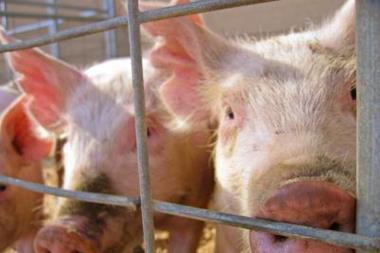Livestock rustling is back, with the bitter twist of rising meat prices leading farmers to steal from each other. As rural insurers advise stepping up security, Lauren MacGillivray meets a farmer whose free-range piglets have been flying into thieves’ vans.
MISS?PIGGY (let’s call her that because pigs aren’t named on this kind of farm) pushes her big, slimy snout deep into the mud and roots around for stones – the favourite pastime of the farm’s thousands of inhabitants. She seems blissfully unaware of not only her commercial fate, but the fact that a gang of thieves is also out for her hide.
The animal lives at Packington Pork farm in Hopwas, Staffordshire, where 481 piglets worth £22,000 were stolen in a single blitz. The brazen hog heist happened in late March but more than a month later, the signs are still visible.
Heavy tracks – likely from a large tractor pulling a lorry-sized trailer – can still be seen leading from a side road and through a wood to the back of the farm. Red paint is ground into the path’s boundary posts where the bulky vehicles squeezed through. A fence at the edge of the farm is cut and smashed to the ground.
A neighbour had tried to alert the farm’s owner, Rob Mercer, when he heard loud banging at 3am. But by the time Mercer arrived, the thieves were long gone. No arrests have been made but Mercer believes the soaring price of meat led a fellow farmer to steal the 14 kennels of weaners (six-week-old piglets) that were still four months from being slaughtered.
“Normally you’d steal pigs which are ready to slaughter because most of the time, if you’re nicking 15 to 20 pigs, it would be gypsy types who would slaughter them for meat,” he says. “But as far as getting the most value on a lorry goes, because of the fact that [weaners] are smaller, these would have been the most value.
“It’s a really small industry so you wouldn’t be able to steal that many pigs and then go and sell them to someone without getting noticed. But farmers would have somewhere to keep the pigs until they were ready for slaughter. They would also be able to make their own food, so they wouldn’t have to ask for feed.”
The question for insurers is, was this an isolated incident or part of a growing and costly trend? After a visit to Packington by Insurance Times, it’s clear that Mercer – who’s claiming £38,000 from NFU Mutual including £22,000 for the stolen pigs and the rest for loss of profit – thinks it’s a growing problem.
His right-hand man, pig production manager John Clappison, has also never experienced rustling on such a scale. With Mercer busy in the office, Clappison showed Insurance Times where the break-in had happened.
Meanwhile, William Barne, a director for Lycetts and head of the rural broker’s Edinburgh office, says he doesn’t believe rustling is a large-scale problem because livestock are tagged and tracked so carefully: each animal has to have a passport in order to be sold or traded. But when he hears about the theft at Packington, he says: “That’s a big theft; I’ve never come across any livestock rustling on that scale.”
In the same month, 80 lambs and ewes were reported missing from Bridgewater, Somerset, and 20 sheep about to lamb disappeared from a field near Ulverston, Cumbria. This prompted the National Farmers' Union to warn of “evidence of a concerning degree of organisation among criminals” due to the rising price of pigs, sheep and cattle. It advised farmers to make sure their insurance is adequate.
In a press release from the union, a spokesman for NFU Mutual said: "Rural thieves are very quick to target whatever they can sell on for a quick buck. Last summer's high fuel prices and scrap metal prices led to thefts across the country. Now rises in the price of meat and the economic downturn are sounding alarm bells . . .
“While we haven't any statistics yet to confirm that rustling is on the increase nationally, NFU Mutual has just got figures through which show that claims of thefts from rural homes increased by 14% in 2008. We are advising farmers to make sure that security on their premises is up to scratch – and that they have insurance in place.”
Insurance can be arranged easily enough. But Mercer says security remains a challenge – particularly for free range animals, which are kept outside. Packington has alarms around the buildings and sensor beams on some of the gates. There’s also an electric fence to keep foxes out. But it isn’t enough to secure a big outdoor site.
At Packington, the pigs are kept over 200 acres and the farm is divided into four sections. The first section is where sows are artificially inseminated and then scanned. Next they’re put in the farrowing area to give birth in a hut, but are still free to roam. When the piglets are big enough they move to an outdoor kennel. As they get mature, they are moved to the “tents”, which is a larger sheltered outdoor area.
Piglets are separated from their mothers after 28 days and go to an abattoir at 22 weeks. Packington sells about 1,000 pigs a week. Of those, about 250 are free range, the most expensive pigs and those targeted by the thieves.
Mercer’s farm follows strict free range and RSPCA guidelines. For him, pigs are not pets – they’re his business, his livelihood. He’s been working with pigs since he was nine years old. The burly, red-headed 28-year-old still helps his father, Roger, with an indoor piggery, but his decision to start a free range operation is a departure from the past. Unfortunately, it also makes him a more likely target for thieves.
Mercer is typical of rural insurance policyholders – he’s a fourth-generation farmer who knows his business inside out, and has no trouble asking for what he wants. After his pigs were stolen, he asked NFU to offer a reward to whoever can find the pigs. So far, his idea has been rejected. “They’re going to have to fork out quite a bit of money. So why not put £7,000 towards a reward? Then, they’d only have to pay the reward if the pigs are found, and they wouldn’t have to pay the claim. I don’t see the downside.”
Like any farmer, Mercer has experienced his struggles. The pig industry hit a rough patch for a couple of years when the cost of pig feed (grain and soya) went up. But his pigs are now worth around £45 each compared with about £30
18 months ago. Now, his biggest challenges are rustling, the credit crunch, and of course swine flu. The World Health Organisation has said the virus can’t be caught from eating pork, but the public might be put off. Either way, with all these threats in mind, farmers should go the whole hog on insurance.
Postscript
Swine flu in perspective
It’s a pork farmer’s worst nightmare – a deadly virus that’s caused by pigs. Besides worrying about a drop in pork sales, there are also liability issues to consider if employees or pork consumers are affected.
Rob Mercer, owner of Packington Pork farm in Hopwas, Staffordshire, said he’s worried about how consumers might perceive the risk of swine flu, however wrong that perception might be.
The World Health Organisation has said the virus cannot be contracted by eating pork but countries such as Russia, China and Japan have banned imports of US, Canadian and Mexican pork, and the issue has made international headlines.
“The fact that it’s called swine flu could affect business. So I’ve sent a message to my butcher’s shop, which is a statement saying you can’t catch swine flu from eating pig meat.”
But he adds that he’s not worried about himself or his staff getting infected. “I’ve got no problem that any of my guys are going to catch pig flu from normal, day-to-day work with the pigs. I don’t think that will happen at all.”
As Insurance Times went to press, 22 countries had officially reported 1,516 cases of influenza A (H1N1) infection. Mexico had reported 822 laboratory confirmed human cases of infection, including 29 deaths and the United States had reported 403 laboratory confirmed human cases, including one death. The UK had reported 27 laboratory confirmed cases with no deaths.



































